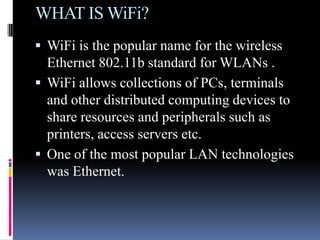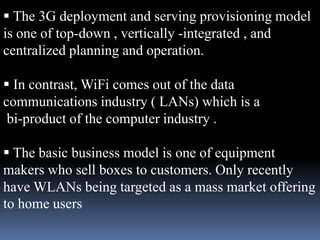3 g vs wifi
- 1. 3G VS WI-FI
- 2. WHAT IS 3G? 3G is a technology for mobile service providers. Mobile services are provided by service providers that own and operate their own wireless networks and sell mobile services to end user. The key feature of mobile service is that it offers continuous coverage.
- 3. Third Generations (3G) mobile technologies will support higher bandwidth digital communications. To expand the range and capability of data services that can be supported by digital mobile systems, service providers will have to upgrade their networks to one of the 3G technologies which can support data rates from 384Kbps up to 2Mbps
- 4. WHAT IS WiFi? WiFi is the popular name for the wireless Ethernet 802.11b standard for WLANs . WiFi allows collections of PCs, terminals and other distributed computing devices to share resources and peripherals such as printers, access servers etc. One of the most popular LAN technologies was Ethernet.
- 5. WiFi LANs operate using unlicensed spectrum in the 2.4 GHz band . The current generation of WLANs supports upto 11Mbps, data rates within 300 feet of the base station. The base station equipment is owned and operated by the end-user community .
- 6. Specification 3G WiFi Standard WCDMA IEEE 802.11 CDMA2000 Max Speed 2Mbps 54Mbps Operations Cell Phone Individual ISP License Yes No Coverage Area Several Kms ~100m Advantages Range, Mobility Speed, Cheap Disadvantages Slow, Expensive Short Range
- 7. HOW ARE WiFi AND 3G SAME? 1.Both technologies are wireless which Avoids need to install cable drops to each device when compared to wire line alternatives. Facilitates mobility ,this includes both the ability to move devices around having to move cables and furniture and the ability to stay continuously connected over wider serving areas.
- 8. 2. BOTH ARE ACCESS TECHNOLOGIES. They offer alternatives to the last- mile wire line network. For 3G, the wireless link is from the end- user device to the cell base station (up to a few kilometers). For WiFi , the wireless link is a few hundred feet from the end-user device to the base station. The base station is then connected either into the wire line LAN or enterprise network infrastructure .
- 9. 3. BOTH OFFER BROADBAND DATA SERVICE Both 3G and WiFi support broadband data service, although the data rate offered by WiFi is substantially higher than the couple of hundred Kbps expected from 3G services . The key is that both will offer sufficient bandwidth to support a comparable array of services data . In this sense both will support “broadband”. Both services will also support "always on " connectivity which is another very important aspect of broadband service .
- 10. HOW 3G AND WiFi ARE DIFFERENT? 1. CURRENT BUSINESS MODELS ARE DIFFERENT 3G represents an extension of the mobile service provider model. The basic business model is the telecommunication services model (similar to wire line telephone business). The service is conceptualized usually as a mass - market offering to both residential and business customers on a subscription basis .
- 11. The 3G deployment and serving provisioning model is one of top-down , vertically -integrated , and centralized planning and operation. In contrast, WiFi comes out of the data communications industry ( LANs) which is a bi-product of the computer industry . The basic business model is one of equipment makers who sell boxes to customers. Only recently have WLANs being targeted as a mass market offering to home users
- 12. 2.SPECTRUM POLICY AND MANAGEMENT. This is one of the key distinctions between 3G and WiFi . 3G and other mobile technologies use licensed spectrum, while WiFi uses unlicensed shared spectrum. With licensed spectrum, the licensee is protected from interference from other service providers . In contrast, the unlicensed spectrum used by WiFi imposes strict power limits on users and forces users to accept interference from others.
- 13. THE OTHER DIFFERENCES ARE.. The two technologies differ with respect to their stage of development in a number of ways . Deployment status. Embedded support for services. Standardization.
- 14. Applications Using 3G… Business services Finance services Mobile office Virtual banking Narrowcast business TV On-line billing Virtual workgroups Universal USIM and credit card Expertise on tap Entertainment Audio on demand Games Video clips Virtual sightseeing
- 15. Applications using WiFi… Home-based WiFi enabled device helps you to connect your PC, game console or laptop. If 2 or 3 members of your family have their own laptops they would be able to share their data, files and photos. There are no boundaries if you are using WiFi, you move from one room to another or even away from home you have the liberty to access internet within the range of radial distance.
- 16. In an office set up, all the computers can be interconnected and enable check and balance whether employs are working or not. A project can be presented to all the members whether in the form of excel sheet or word document. Many public places are also supplied with WiFi connectivity to access internet like café, restaurants, and clubs to attract the clients. A prospect customer surely appreciates your efficiency and awareness of the modern fast-paced world. WiFi is not limited to private users or small-business communities. Its future is predictable as WiFi is applicable in a versatile modes and profitable ways.
- 17. CONCLUSION: The two technologies are 3G , which is the preferred upgrade path for mobile providers , and WiFi , one of the many WLAN technologies. The goal of the analysis is to explore two divergent world views for the future of wireless access and to speculate on the likely success and possible interactions between the two technologies in the future. First, both technologies are likely to succeed in the market place. This means that the wireless future will include heterogeneous access technologies.
- 18. Second we expect 3G mobile providers to integrate WiFi technology into their networks thus expecting these two technologies to be complimentary in their successful mass market deployment . Third, we also expect WiFi to offer competition to 3G providers because of the lower enter costs associated with establishing WiFi networks.
- 19. THANK YOU…


















